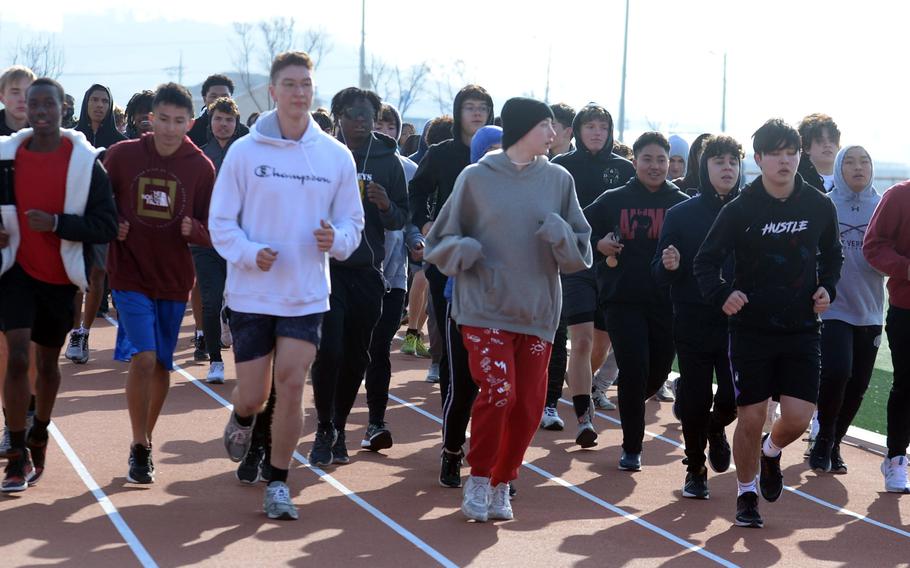
Humphreys' track and field team is a vast group but with a small core of veterans and past champions. It's a question, new coach Mark Tyler says, how quickly they will grow to reach the same level they did in 2019 when the Blackhawks won the Far East Division I overall school championship. (Dave Ornauer/Stars and Stripes)
YOKOSUKA NAVAL BASE, Japan – Track and field coaches and athletes say they’re overjoyed that they’ll get an in-person Far East meet next month at Yokota, after a two-year COVID-induced hiatus.
But that joy is tempered by one pressing question: How well will athletes do, after running, jumping and throwing before the video cameras, with no real foes, in virtual Far East meets the last two years?
Tough to tell, a handful of coaches say.
Qualifying standards for the Far East meet, scheduled for April 24-26 at Yokota, remain the same as they did in the last Far East, back in 2019. But athletes may need more time (maybe too much?) to reach those qualifying marks consistently as they did back then.
“We used to have a dozen or so qualify” for every event at Far East meets in years past,” Nile C. Kinnick coach Luke Voth said. But those numbers dwindled the past two years for the virtual meets.
During the COVID-induced restrictions at various bases around the Pacific, “you had to wear masks while running. We had no (regular-season) competitions. I called it a shutdown for two years. Virtual meets are not the same,” Voth said.
It's not for lack of athletes in general; schools throughout the Pacific saw the number of track and field athletes increase now that the end-of-season pot of gold has returned.
“I have a huge team; they’re just inexperienced,” Voth said of his Red Devils. “I’d imagine a lot of the other schools are the same way.”
DODEA schools in Japan and Okinawa got their first taste of in-person track Saturday at Yokota and Kadena. DODEA-Korea’s regular season opens next Saturday at Humphreys.
Voth and the Red Devils will count on senior sprinter Jeremiah Hines and sophomore Far East Division I cross country champion Mia Bartram, among a handful of others.
Led by three seniors - sprinter Javonte Vickers, past Far East cross country D-I champion Karise Johsnon and thrower Destiny Richardson - Kadena could make some noise, especially on the boys side, but coach Reginal Winn says his girls team is rebuilding.
“It will take at least two or three seasons” for athletes throughout the region to regain the edge and chase Pacific and Far East meet records again, Winn said.
Kubasaki had 67 athletes sign up and coach Kenneth Gipson says he expects that 60 will be his team’s final number. He has a strong cadre of athletes with potential; sophomore Zierre Paul was a virtual hurdles champion last year and junior Makayla Saeteurn is an accomplished distance runner.
Humphreys, Division I overall school champion back in 2019, also has strong numbers and past virtual champions in senior Ethan Elliott, junior Anayah Reyes and junior Andrew Wahlgren. How quickly the whole group develops is a matter of time, first-year coach Mark Tyler said.
Among Division II schools, Matthew C. Perry could make some noise on the strength of their distance corps, led by Far East D-II cross country champion Jane Williams and past champion Tyler Gaines.
Freshman Far East D-II cross country champion Sam Wood will run distance for Osan. Robert D. Edgren senior Far East virtual hurdles champion Zalea Washington also returns.
Liliana Fennessey and Gabriel Escalera are distance anchors for Zama, though the Trojans have fewer athletes out than they have had in the past.
Yokota might have the best overall depth among D-II schools; coach Dan Galvin says more than 60 athletes came out and he has multiple athletes in each event. Senior middle-distance runner Tate Rannow and hurdler-jumper Trinity Stegall, a junior, will lead the way for the Panthers.
“We lucked out on the volunteer coaches this year, too,” Galvin said. “A nice group of highly experienced and motivated coaches are really helping us in events where we have struggled in the past just to get numbers, like the jumps and the hurdles.”